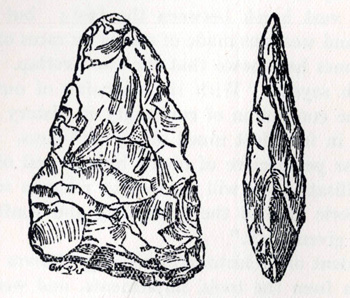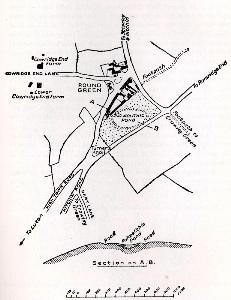
Palaeolithic implement found by William Gutteridge
The Old Stone Age, or Palaeolithic, lasted from the appearance of modern humans, around 500,000 BC, to somewhere around to about 10,000 BC and was succeeded by the Middle Stone Age, or Mesolithic. At this remote time, humans began to make stone tools and began to domesticate animals in agriculture. Not surprisingly the only record of humans in Luton at this date comes from finds of their stone tools. Altogether the count is in excess of 800 separate artefacts, many of them flakes.
There are a large number of spots in the Borough of Luton where Palaeolithic implements have been found. It should not be surprising, given that the underlying geology for much of the area is clay with flints, in other words, the raw material for making stone tools was plentiful. The earliest discovery was made in 1830 when a handaxe was found lying on the surface at Dallow Farm by the farmer, William Gutteridge. The axe is now in the British Museum
In 1884 Worthington George Smith, as noted in his Man the Primeval Savage of 1894, found a Palaeolithic axehead in river gravel at Leagrave, not far from Waulud's Bank. He found a handaxe on the surface in Leagrave three years later describing it as flat and ovate. Further Palaeolithic flakes have been found in gravel pits at Leagrave at a height of 380 feet above sea-level [National Monument Number 359727] and four handaxes, three retouched flakes and thirteen other flakes, without specific provenance, have also been found at Leagrave. The Bedfordshire Historic Environment [HER193] records a group of five handaxes and three flakes found at Stopsley at an unknown date. It also records a handaxe and two flakes found at differing parts of the town, the flakes in 1886 [HER648] and two flakes found at Farley Green at an unknown date [HER651].

Map in William Austin's History of Luton showing the site of Worthington George Smith's excavations at Round Green - to see a larger image please click on the picture
In the 1890s W. G. Smith found a Palaeolithic flake, along with animal bonesand a human skeleton in a clay pit at Mixes Hill, as he noted in Man the Primeval Savage. Smith found a number of implements in a brickyard at Turner's Knoll in 1916 as he reported in Archaeologia, journal of the Society of Antiquaries. These included twenty one sharp flints, nine knives, a sharp edged core and a staggering 261 flakes. He also found a wealth of material at a site in nearby Round Green, between Ramridge Road and Turners Road, consisting of twenty six handaxes, four rough outs, twenty two cores, fifteen retouched flakes, fifteen miscellaneous objects and no less than 282 other flakes. William Austin in Volume 1 of his History of Luton of 1928 said: "About the circumference of the Palaeolithic pond at Round Green Mr. Smith found implements and tools which were specially instructive. During the excavation the entire "stock-in-trade" of the pond dwellers was exposed, and every scrap of worked flint was removed…That it was a true work-shop was proved, not only by the number and situation of the implements but by the fact that some flakes were actually fitted by Mr. Smith on the implements from which they had been struck". One should, perhaps, be careful not to interpret this site as some kind of work-shop or factory as that implies a rather modern outlook. Also, it is impossible to say whether the work was all done at once, over a matter of years or of generations. Smith also found eleven handaxes, a retouched flake, a miscellaneous object and seventy two flakes at a clay pit at Ramridge End [HER364].

Turner's Knoll September 2009
The Bedfordshire Historic Environment Record [HER649] has a record of several Palaeolithic implements found in gravel pits at Biscot Grange between 1915 and 1918. Numerous flakes were noted but no further information is available on them. Several handaxes in good condition were found, along with scrapers and other, unspecified, implements. Other flints were discovered at the same time in nearby Limbury [HER646] and it is possible that the two finds became confused. Finds were said to have included handaxes, flints and other implements.
At some unspecified date before about 1937 five handaxes and three flakes were found at a clay pit worked by George Powdrill and Sons at Stopsley. William Austin recorded in his History of Luton of 1928 that in 1922 a man named Evans found a stone pick whilst tending his allotment on the west side of New Bedford Road [Monument Number 359736 - which notes that it may be Palaeolithic or Mesolithic]. Undated finds include seventeen handaxes, a rough out, eight retouched flakes and eight other flakes from a gravel pit at Limbury. National Monument Number 1143729 is a spot on Farley Green and Common where three retouched flakes and seven other flakes were found in a dry valley cutting through a geology of clay with flints. Four handaxes, a retouched flake and another flake have all been found in various sites around New Bedford Road and now lie not far away in Luton Museum [HER654]. A handaxe was discovered at Dane End on the southern edge of Luton Airport. The Bedfordshire Historic Environment Record [HER2856] notes that in 1971 Palaeolithic implements and animal bones were found on Leagrave Common and are now in Luton Museum. Fieldwalking by the Luton and District Archaeological Society in the Autumn in 1987 in a field to the south-west of White Hill Farm produced a thin scatter of hard hammer struck flint flakes close to Upshot Wood [HER 15226].
Altogether this suggests that the area of today's Luton was significantly exploited by our remote ancestors for its flint. It is a shame that no traces of habitation can be detected from such an ancient time.